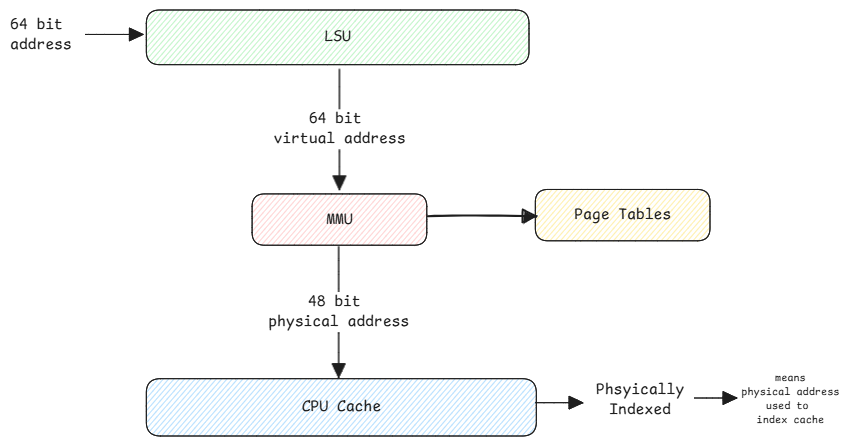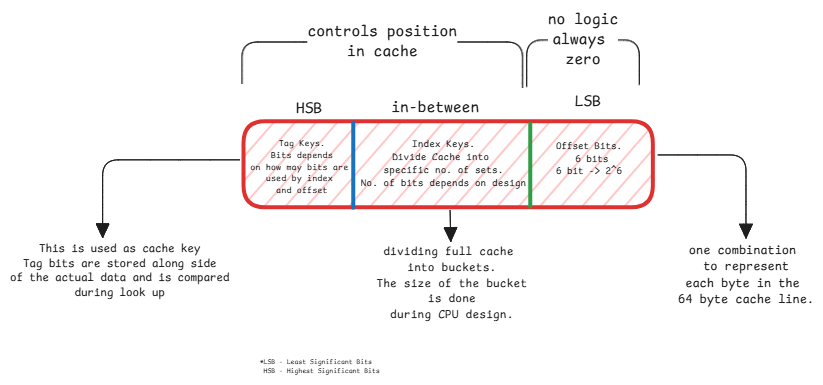CPU Caching
CPU has multiple levels of cache (L1, L2, L3) to speed up data access. Each cache level is larger and slower than the previous one, with L1 being the smallest and fastest, and L3 being the largest and slowest.
- Large - More data can be stored.
- Slow - The cache key has to be searched from the largest data set and also the cache must move from different levels to L1 and then finally to the register.
All data reading and writing happens via CPU cache. This is because the assumption is that whatever data is currently requested, is also required in the near future.

Cache Lines
Cache line is nothing but the each cache entry size. This is a fixed value across all cache levels. Typically, a cache line is 64 bytes. This value is something fixed by the CPU manufacturer and can't be changed or configured by the user.
The line here is actually a specific block of memory in the cache. Entire cache area is split into fixed size blocks called cache lines.
Cache Addressing
The CPU asks for data at a specific address. To get the data from that specific address, the CPU cache controller has a logic to use the corresponding physical address itself as cache key to search in the cache.
Note that the entire caching happens using the physical address and not the virtual address.

Cache Key Calculation
- Offset bits - set to zero. Means the address of the starting byte of the cache line.
- Index bits - used to identify which cache set.
- Tag bits - This is the actual cache key. This must match.
Since the index bits are repeated across multiple cache lines, the tag bits are used to uniquely identify the cache line.

- Divide the entire cache size by the cache line size to get the number of cache lines it can hold.
- Then divide the number of cache lines per set to get the number of sets. This is the associativity of the cache. For example, if the cache is 4-way associative, then each set will have 4 cache lines.
- Then use the index bits to calculate the index key.
In case of L1 Cache of 32 KB with 64 B cache line size and 4-way associativity:
- Number of cache lines = 32 KB / 64 B = 512 lines.
- Number of sets = 512 lines / 4-way associativity = 128 sets.
- Index key = 7 bits to get address 128 sets.
This same logic is used to split all 3 levels of cache. Just different 'N-way' associativity is used to split the cache lines into sets.
This is very similar to how we calculate the index key for hash tables.
Zeroing-Out Bits
When the LSU(Load/Store Unit) component of CPU asks for data at a specific address, the MMU gets the physical address of it and sends it to the cache controller. The cache controller then always sets the last 'N' bits depending on the cache line size to zero.
If the cache line is 64 bytes, then the last 6 bits are set to zero. This is necessary to fetch the data before and after the requested address to provide spatial locality.
This is because the cache line has 64 bytes and the last 6 bits are necessary to address each of this byte individually.
The LSU then uses it's multiplexer to extract the relevant data from the cache line. It means, LSU knows the exact byte it needs to extract from the cache line data it received from the cache controller.
Writing data back to memory
Most common way is to use 'Write-Back' policy.
- LSU issues STORE instruction to write data to cache.
- Cache controller checks if the cache line is already present in the cache.
- If present, it updates the cache line and marks it as dirty.
- When cache is evicted, then the updated cache line is written back to the next level. Eventually when it's evicted from L3, it's written back to the main memory.
When a write happens during a cache miss, then the data is loaded all the way from the main memory to the cache and then written back to the cache and the dirty flag is set.
Aligned and non-aligned access
When the CPU wants 4 byte data but if the start of the first byte falls under an address that leads to a cache line boundary, then it may need to access two cache lines to fetch the complete 4 bytes.
In this case, the hardware will have to do two memory fetches and then concatenate the bytes and send to CPU.